glove box Hyundai Matrix 2005 User Guide
[x] Cancel search | Manufacturer: HYUNDAI, Model Year: 2005, Model line: Matrix, Model: Hyundai Matrix 2005Pages: 407, PDF Size: 10.31 MB
Page 201 of 407

1
FEATURES OF YOUR HYUNDAI
37
o Improper handling of the pre-
tensioner seat belt assemblies, and failure to heed the warnings to not strike, modify, inspect, re-place, service or repair the pre- tensioner seat belt assemblies may lead to improper operationor inadvertent activation and se- rious injury.
o Always wear seat belts when driv-
ing or riding in a motor vehicle. B240A03F-GAT (If Installed) Your Hyundai is equipped with a Supplemental Restraint (Airbag) Sys- tem. The indications of the system's presence are the letters "SRS AIRBAG" embossed on the airbag pad cover in the steering wheel and the passenger's side front panel pad abovethe glove box. The Hyundai SRS consists of airbags installed under the pad covers in the center of the steering wheel and the passenger's side front panel above theglove box. The purpose of the SRS is to provide the vehicle's driver and/orHFC1073
Driver's Airbag
SUPPLEMENTAL RESTRAINT (AIRBAG) SYSTEM
!
the front passenger with additional pro- tection than that offered by the seatbelt system alone, in case of a frontal impact of sufficient severity. NOTE: Be sure to read information about the SRS on the labels provided on the backside of the sun visor and in the glove box.
WARNING:
o As its name implies, the SRS is designed to work with, and besupplemental to, the driver's and the passenger's three point seat belt systems and is not a substi-tute for them. Therefore your seat belts must be worn at all times while the vehicle is in motion. Inaddition, the airbags deploy only in certain frontal impact condi- tions severe enough to causesignificant injury to the vehicle occupants.
Page 202 of 407
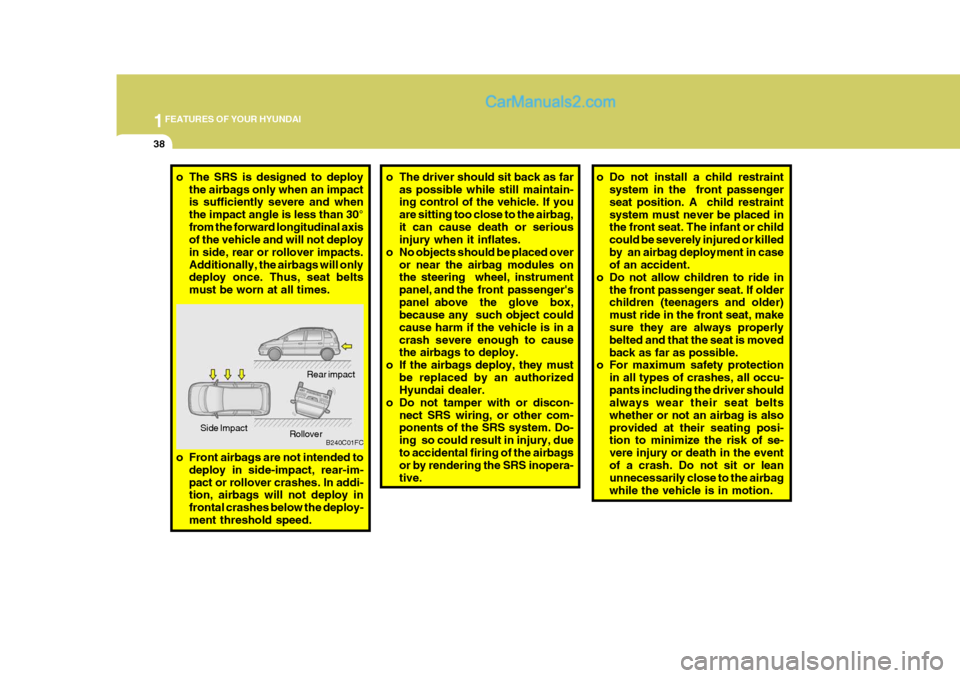
1FEATURES OF YOUR HYUNDAI
38
o Front airbags are not intended to
deploy in side-impact, rear-im- pact or rollover crashes. In addi- tion, airbags will not deploy in frontal crashes below the deploy-ment threshold speed.
o Do not install a child restraintsystem in the front passenger seat position. A child restraintsystem must never be placed in the front seat. The infant or child could be severely injured or killedby an airbag deployment in case of an accident.
o Do not allow children to ride in
the front passenger seat. If olderchildren (teenagers and older) must ride in the front seat, makesure they are always properly belted and that the seat is moved back as far as possible.
o For maximum safety protection
in all types of crashes, all occu-pants including the driver should always wear their seat belts whether or not an airbag is alsoprovided at their seating posi- tion to minimize the risk of se- vere injury or death in the eventof a crash. Do not sit or lean unnecessarily close to the airbag while the vehicle is in motion.o The driver should sit back as far
as possible while still maintain- ing control of the vehicle. If you are sitting too close to the airbag,it can cause death or serious injury when it inflates.
o No objects should be placed over or near the airbag modules onthe steering wheel, instrument panel, and the front passenger'spanel above the glove box, because any such object could cause harm if the vehicle is in acrash severe enough to cause the airbags to deploy.
o If the airbags deploy, they must be replaced by an authorizedHyundai dealer.
o Do not tamper with or discon- nect SRS wiring, or other com-ponents of the SRS system. Do- ing so could result in injury, dueto accidental firing of the airbags or by rendering the SRS inopera- tive.
o The SRS is designed to deploy
the airbags only when an impact is sufficiently severe and when the impact angle is less than 30°from the forward longitudinal axis of the vehicle and will not deploy in side, rear or rollover impacts.Additionally, the airbags will only deploy once. Thus, seat belts must be worn at all times.
B240C01FC
Rear impact
Side Impact Rollover
Page 203 of 407
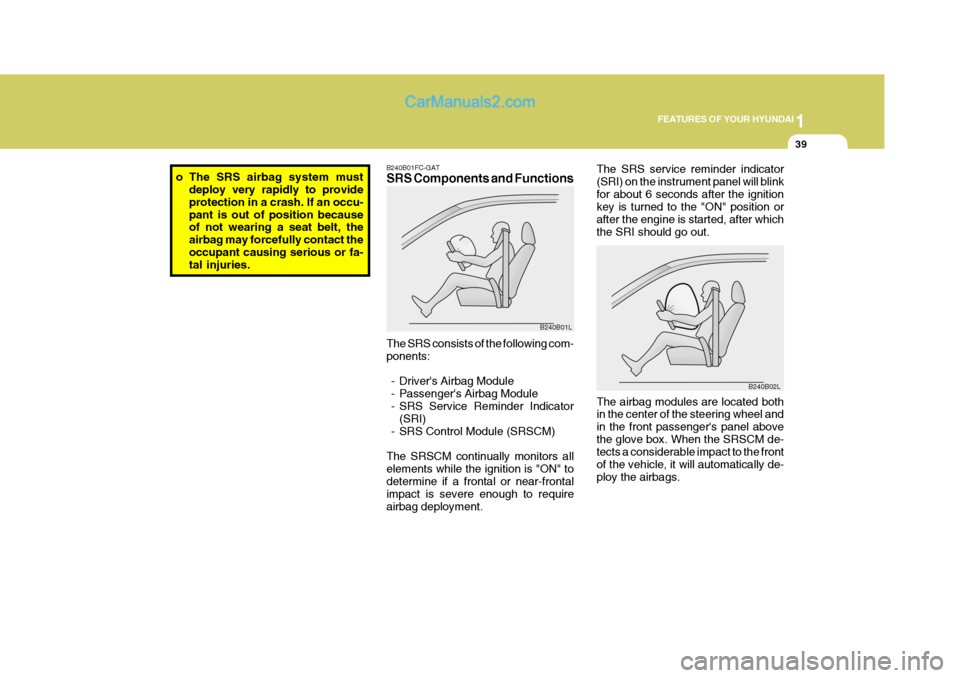
1
FEATURES OF YOUR HYUNDAI
39
o The SRS airbag system must
deploy very rapidly to provide protection in a crash. If an occu-pant is out of position because of not wearing a seat belt, the airbag may forcefully contact theoccupant causing serious or fa- tal injuries. B240B01FC-GAT SRS Components and Functions
B240B01L
The SRS consists of the following com- ponents:
- Driver's Airbag Module
- Passenger's Airbag Module
- SRS Service Reminder Indicator (SRI)
- SRS Control Module (SRSCM)
The SRSCM continually monitors all elements while the ignition is "ON" to determine if a frontal or near-frontal impact is severe enough to requireairbag deployment. B240B02L
The airbag modules are located both in the center of the steering wheel and in the front passenger's panel abovethe glove box. When the SRSCM de- tects a considerable impact to the front of the vehicle, it will automatically de-ploy the airbags.
The SRS service reminder indicator(SRI) on the instrument panel will blinkfor about 6 seconds after the ignition key is turned to the "ON" position or after the engine is started, after whichthe SRI should go out.
Page 204 of 407
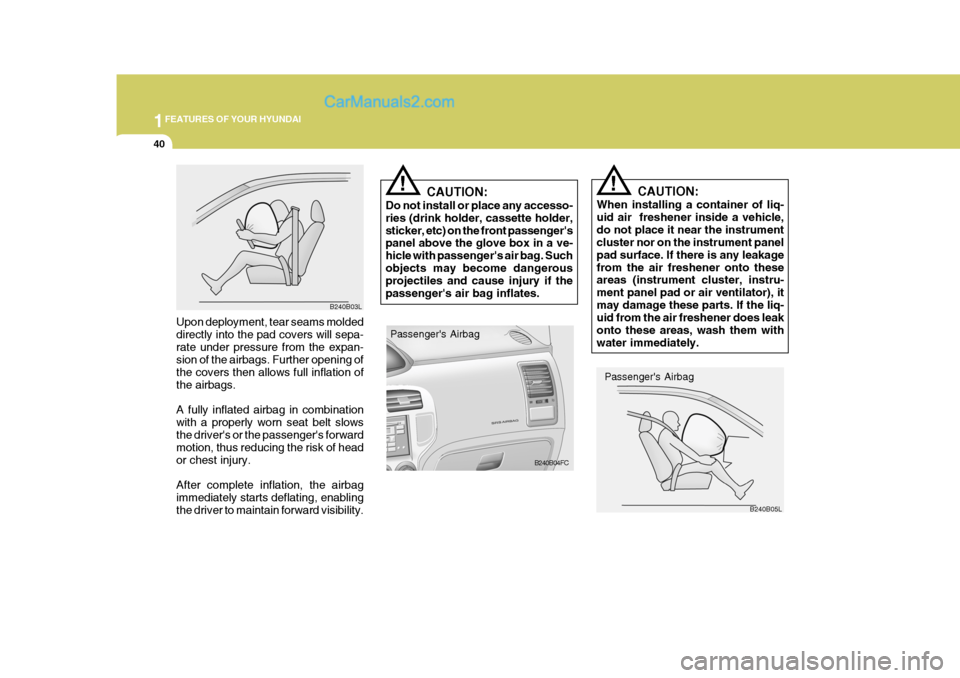
1FEATURES OF YOUR HYUNDAI
40
CAUTION:
When installing a container of liq- uid air freshener inside a vehicle,do not place it near the instrument cluster nor on the instrument panel pad surface. If there is any leakagefrom the air freshener onto these areas (instrument cluster, instru- ment panel pad or air ventilator), itmay damage these parts. If the liq- uid from the air freshener does leak onto these areas, wash them withwater immediately.!
CAUTION:
Do not install or place any accesso- ries (drink holder, cassette holder,sticker, etc) on the front passenger's panel above the glove box in a ve- hicle with passenger's air bag. Suchobjects may become dangerous projectiles and cause injury if the passenger's air bag inflates.!
Passenger's AirbagB240B05L
B240B03L
Upon deployment, tear seams molded directly into the pad covers will sepa-rate under pressure from the expan- sion of the airbags. Further opening of the covers then allows full inflation ofthe airbags. A fully inflated airbag in combination with a properly worn seat belt slows the driver's or the passenger's forward motion, thus reducing the risk of heador chest injury. After complete inflation, the airbag immediately starts deflating, enabling the driver to maintain forward visibility. Passenger's Airbag
B240B04FC
Page 207 of 407
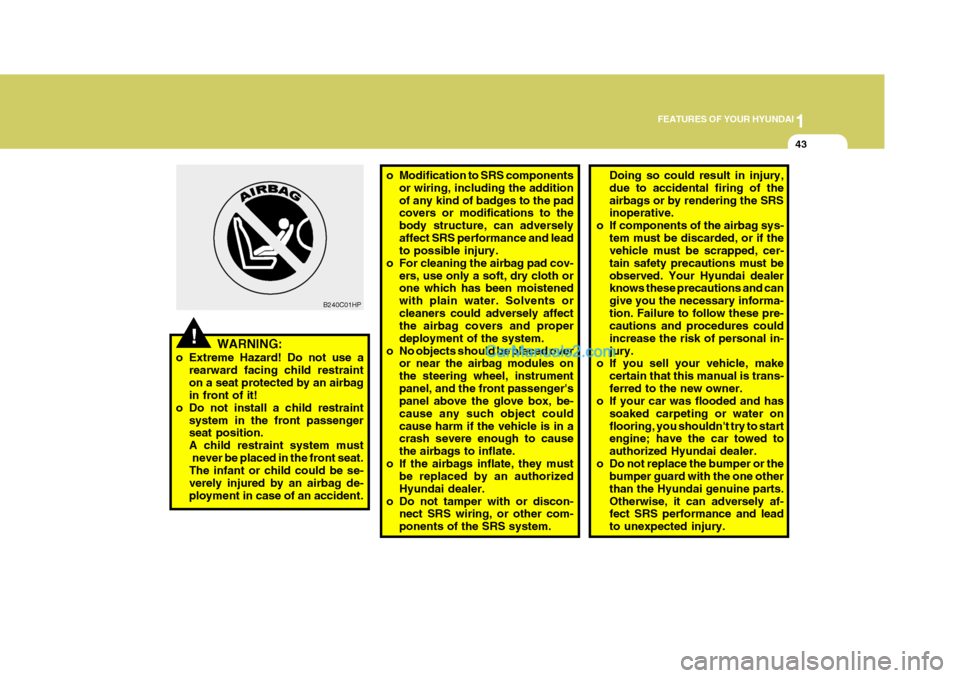
1
FEATURES OF YOUR HYUNDAI
43
B240C01HP
!
o Modification to SRS components
or wiring, including the addition of any kind of badges to the pad covers or modifications to the body structure, can adverselyaffect SRS performance and lead to possible injury.
o For cleaning the airbag pad cov- ers, use only a soft, dry cloth orone which has been moistened with plain water. Solvents orcleaners could adversely affect the airbag covers and proper deployment of the system.
o No objects should be placed over or near the airbag modules onthe steering wheel, instrumentpanel, and the front passenger's panel above the glove box, be- cause any such object couldcause harm if the vehicle is in a crash severe enough to cause the airbags to inflate.
o If the airbags inflate, they must be replaced by an authorizedHyundai dealer.
o Do not tamper with or discon- nect SRS wiring, or other com-ponents of the SRS system.
WARNING:
o Extreme Hazard! Do not use a rearward facing child restrainton a seat protected by an airbag in front of it!
o Do not install a child restraint system in the front passengerseat position. A child restraint system must
never be placed in the front seat. The infant or child could be se- verely injured by an airbag de-ployment in case of an accident. Doing so could result in injury,due to accidental firing of theairbags or by rendering the SRS inoperative.
o If components of the airbag sys-
tem must be discarded, or if thevehicle must be scrapped, cer- tain safety precautions must beobserved. Your Hyundai dealer knows these precautions and can give you the necessary informa-tion. Failure to follow these pre- cautions and procedures could increase the risk of personal in-jury.
o If you sell your vehicle, make
certain that this manual is trans-ferred to the new owner.
o If your car was flooded and has
soaked carpeting or water onflooring, you shouldn't try to start engine; have the car towed to authorized Hyundai dealer.
o Do not replace the bumper or the bumper guard with the one otherthan the Hyundai genuine parts.Otherwise, it can adversely af- fect SRS performance and lead to unexpected injury.
Page 233 of 407

1
FEATURES OF YOUR HYUNDAI
69
B480A01E-AAT FRONT INTERIOR LIGHT Map Light The two map light switches are located on both sides of the front overhead console. Push in the map light switch to turn the light on or off. This lightproduces a spot beam for convenient use as a map light at night or as a personal light for the driver and thepassenger. With Sunroof
HFC480
Without Sunroof
INTERIOR LIGHT
HFC1038
4. Turn the wrench clockwise to open or counterclockwise to close.
2. Turn the hexagonal bolts with a socket wrench counterclockwise to remove the front overhead console.
3. Insert the hexagonal head wrench provided with the vehicle into the socket. This wrench can be found inthe vehicle's luggage room or glove box. HFC1037
Page 235 of 407
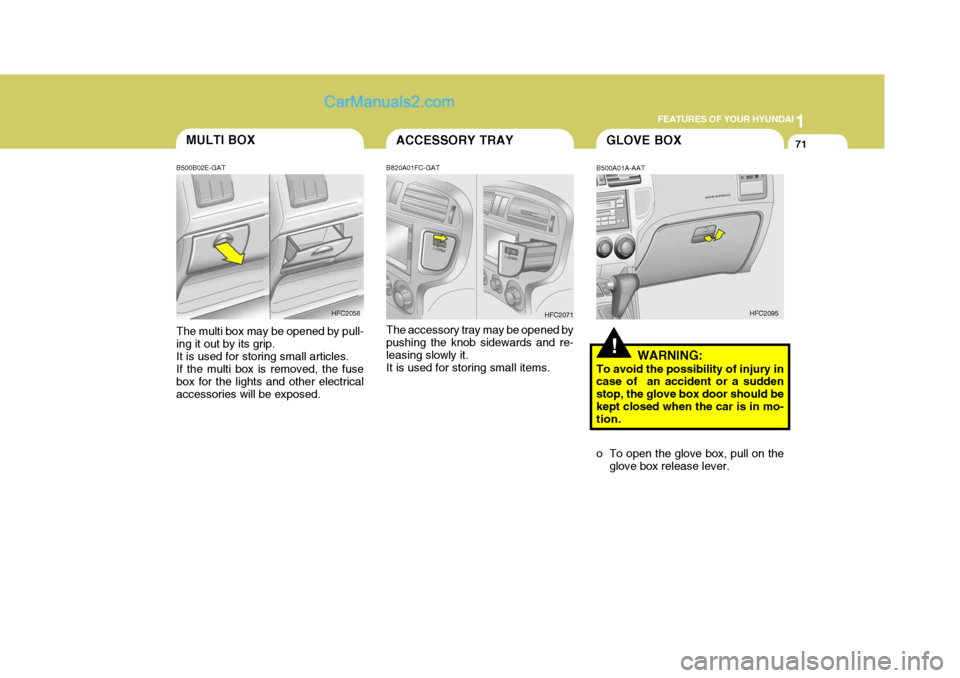
1
FEATURES OF YOUR HYUNDAI
71ACCESSORY TRAY
B820A01FC-GAT The accessory tray may be opened by pushing the knob sidewards and re- leasing slowly it.It is used for storing small items. HFC2071
!
GLOVE BOX
B500A01A-AAT
WARNING:
To avoid the possibility of injury in case of an accident or a sudden stop, the glove box door should bekept closed when the car is in mo- tion.
o To open the glove box, pull on the glove box release lever. HFC2095MULTI BOX
B500B02E-GAT The multi box may be opened by pull- ing it out by its grip.It is used for storing small articles. If the multi box is removed, the fuse box for the lights and other electricalaccessories will be exposed. HFC2058
Page 254 of 407

1FEATURES OF YOUR HYUNDAI
90AIR CONDITIONER FILTER (IN FRONT OF BLOWER UNIT)
B740D01A-AAT Operation Tips
o If the interior of the car is hot when
you first get in, open the windows for a few minutes to expel the hot air.
o When you are using the air condition-
ing system, keep all windows closedto keep hot air out.
o When moving slowly, as in heavy
traffic, shift to a lower gear. Thisincreases engine speed, which in turn increases the speed of the air conditioning compressor.
o On steep grades, turn the air condi- tioning off to avoid the possibility ofthe engine over-heating.
o During winter months or in periods when the air conditioning is not usedregularly, run the air conditioning onceevery month for a few minutes. This will help circulate the lubricants and keep your system in peak operatingcondition. B760A03FC-GAT (If Installed) The air conditioner filter is located in front of the blower unit behind the glove box. It operates to decrease pollutants from entering the car.To replace the air conditioner filter, refer to the page 6-26.
CAUTION:
o Replace the filter every 20,000 km (12,000 miles) or once a year. If the car is being driven in severe con-ditions such as dusty, rough roads, more frequent air condi- tioner filter inspections andchanges are required.
o When the air flow rate is decreased,
it must be checked at an autho-rized dealer.
!
B760A01E
Evaporator core Filter
Heater core
Outside air
Inside air Inside air
Blower fan
Page 337 of 407
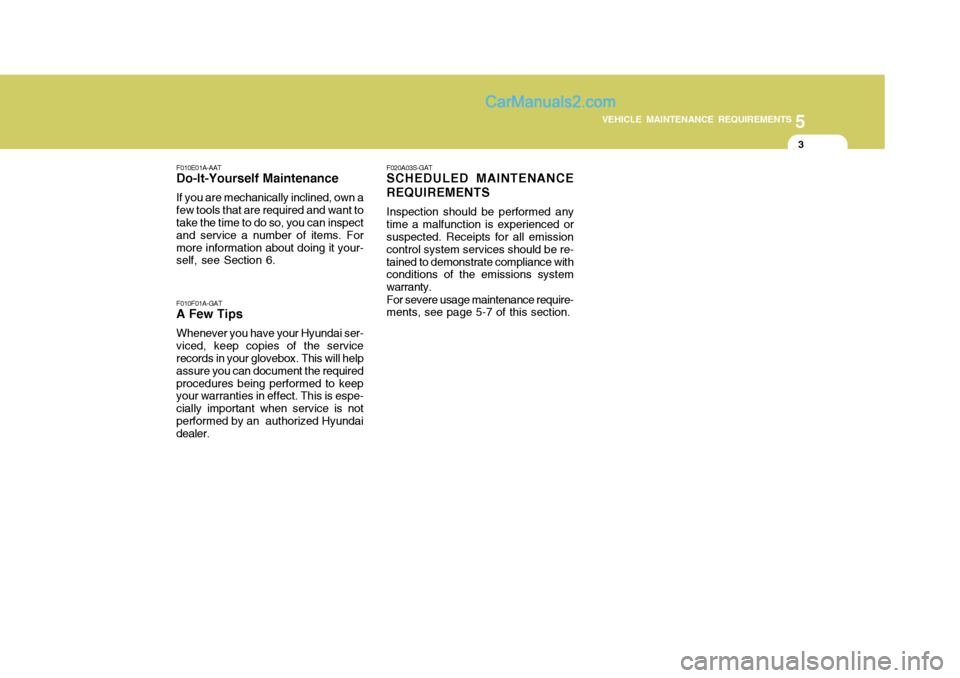
5
VEHICLE MAINTENANCE REQUIREMENTS
3
F010E01A-AAT
Do-It-Yourself Maintenance
If you are mechanically inclined, own a few tools that are required and want to take the time to do so, you can inspect and service a number of items. Formore information about doing it your- self, see Section 6. F010F01A-GAT
A Few Tips
Whenever you have your Hyundai ser- viced, keep copies of the service records in your glovebox. This will help assure you can document the requiredprocedures being performed to keep your warranties in effect. This is espe- cially important when service is notperformed by an authorized Hyundai dealer. F020A03S-GAT
SCHEDULED MAINTENANCE REQUIREMENTS
Inspection should be performed any time a malfunction is experienced or suspected. Receipts for all emission control system services should be re-tained to demonstrate compliance with conditions of the emissions system warranty. For severe usage maintenance require- ments, see page 5-7 of this section.
Page 371 of 407

6 DO-IT-YOURSELF MAINTENANCE
26CHANGING THE AIR CONDITIONER FILTER
G140D01S-GAT Checking the Compressor Drive Belt When the air conditioning is being used regularly, the compressor drive belt tension should be checked at least once a month.To check the drive belt tension, pressdown on the belt halfway between theengine crankshaft and compressor pulleys. Pressing with your finger, you should not be able to deflect this beltanymore than 8.0 mm. If you have the instruments to check it with a force of 98N (22 lb.), the deflectionshould be approx. 8.0 mm (0.315 in.). If the belt is too loose, have it ad- justed by your Hyundai dealer. CRANK PULLEY
G140D01A
A/C
TENSION PULLEY 8mm (0.315 in.)
B140E01FC-AAT
(In Front of Blower Unit)
The air conditioner filter is located in
front of the blower unit behind the glove box.
It helps to decrease pollutants from
entering the car.
1. Open the glove box and remove
the adjusting pins on both sides of the glove box. 2. Remove the filter cover by pulling
upward the hooks of the filter cover.
HLC2096 KQNA020A